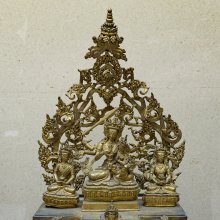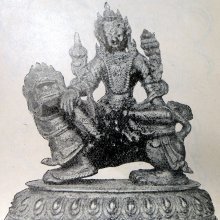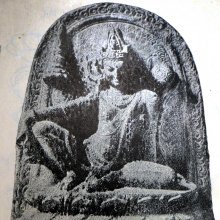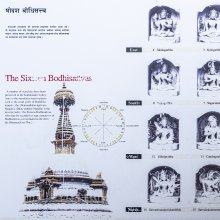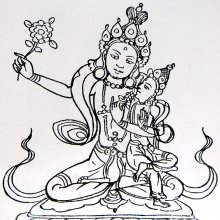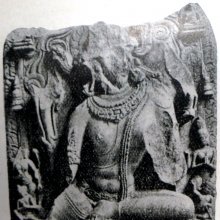Vagishvara, Vāgīśvara: 11 definitions
Introduction:
Vagishvara means something in Buddhism, Pali, Hinduism, Sanskrit. If you want to know the exact meaning, history, etymology or English translation of this term then check out the descriptions on this page. Add your comment or reference to a book if you want to contribute to this summary article.
The Sanskrit term Vāgīśvara can be transliterated into English as Vagisvara or Vagishvara, using the IAST transliteration scheme (?).
Images (photo gallery)
(+2 more images available)
In Hinduism
Shaivism (Shaiva philosophy)
Source: Wisdom Library: ŚaivismVāgīśvara (वागीश्वर) is the name of a Liṅga (symbolical manifestation of Śiva) that is associated with the Vīra-tīrtha (a sacred bathing place). It represents the thirty-sixth of the sixty-four siddhaliṅgas mentioned in the Nepalese Tyasaphu (a folding book or leporello). At each of these spots Śiva is manifest as a Liṅga. Each of these liṅgas (e.g., ) has its own specific name, mantra, set of rituals and observances, auspicious time etc.
The auspiscious time for bathing near the Vāgīśvara-liṅga at the Vīra-tīrtha is mentioned as “śrāvaṇī pūrṇimā” (latin: shravani purnima). This basically represents the recommended day for bathing there (snānadina).

Shaiva (शैव, śaiva) or Shaivism (śaivism) represents a tradition of Hinduism worshiping Shiva as the supreme being. Closely related to Shaktism, Shaiva literature includes a range of scriptures, including Tantras, while the root of this tradition may be traced back to the ancient Vedas.
In Buddhism
Tibetan Buddhism (Vajrayana or tantric Buddhism)
Source: archive.org: The Indian Buddhist IconographyVāgīśvara (वागीश्वर) refers to one of the various forms of Mañjuśrī having their Sādhana described in the 5th-century Sādhanamālā (a collection of sādhana texts that contain detailed instructions for rituals).—His Colour is red or yellow; his Āsana is the adhaparyaṅka; his Vāhana is the lion; his Symbol is the Utpala.—Vāgīśvara is the tutelary deity of the Nepalese Buddhists and is widely worshipped in Nepal. The fact that innumerable prayer-wheels in Nepalese temples bear, in monumental Newari characters, the mantra “Oṃ Vāgīśvara Mūḥ” stands witness to his popularity.
The Dhyāna (meditation instructions) of Vāgīśvara is described in the Sādhanamālā as follows:
Source: Brill: Śaivism and the Tantric Traditions (tantric Buddhism)“The worshipper should think himself as Vāgīśvara whose head is beautified by the images of the five Dhyāni Buddhas. He looks a prince, is decked in all ornaments, and has the complexion of Kuṅkuma. He carries the night lotus in his left hand while the right is displayed artistically. He rides a lion and possesses princely grace Oṃ Vāgīśvara Mūḥ.”.
Vāgīśvara (वागीश्वर) or Vāgīśvarakīrti is the name of an East Indian tantric Buddhist scholar whose views were considered important enough to be contested sometime before 1057ce, probably still during his scholarly activity, in Kashmir. Although unnamed, he is a master alluded to with great reverence on the Sap Bāk inscription from the Khmer Empire, dated 1067ce.—This Vāgīśvara-kīrti should not be confused with his namesake, a Newar scholar from Pharping, whence his epithet Pham mthiṅ ba. Nor should we confuse him with a rather nebulous person, whose name is re-Sanskritised as Suvāgīśvarakīrti, author of a number of small works extant in Tibetan translation. Lastly, there is no good reason to assume that he is the same as a commentator of Daṇḍin’s Kāvyādarśa; this person’s name is often re-Sanskritised from the Tibetan as Vāgīśvara, but it is more likely that his name was Vācaspati or Vāgīśa.

Tibetan Buddhism includes schools such as Nyingma, Kadampa, Kagyu and Gelug. Their primary canon of literature is divided in two broad categories: The Kangyur, which consists of Buddha’s words, and the Tengyur, which includes commentaries from various sources. Esotericism and tantra techniques (vajrayāna) are collected indepently.
Languages of India and abroad
Sanskrit dictionary
Source: Cologne Digital Sanskrit Dictionaries: Edgerton Buddhist Hybrid Sanskrit DictionaryVāgīśvara (वागीश्वर).—a name of Mañjuśrī: Sādhanamālā 94.7 etc.
Source: Cologne Digital Sanskrit Dictionaries: Shabda-Sagara Sanskrit-English DictionaryVāgīśvara (वागीश्वर).—m.
(-raḥ) 1. An orator, a learned man. 2. A Baud'dha deified sage; also Manjughosha. 3. Brahma. f. (-rī) Saraswati. E. vāk speech, īśvara lord.
Source: Cologne Digital Sanskrit Dictionaries: Cappeller Sanskrit-English DictionaryVāgīśvara (वागीश्वर).—[masculine] a master of language.
Source: Cologne Digital Sanskrit Dictionaries: Aufrecht Catalogus Catalogorum1) Vāgīśvara (वागीश्वर) as mentioned in Aufrecht’s Catalogus Catalogorum:—title of Ratnākara, the author of Haravijayakāvya. Report. Cxxvi.
2) Vāgīśvara (वागीश्वर):—a poet, contemporary of Maṅkha. Śrīkaṇṭhacarita 25, 127.
3) Vāgīśvara (वागीश्वर):—a medical author. Mentioned W. p. 306.
4) Vāgīśvara (वागीश्वर):—Mānamanohara.
Source: Cologne Digital Sanskrit Dictionaries: Monier-Williams Sanskrit-English Dictionary1) Vāgīśvara (वागीश्वर):—[=vāg-īśvara] [from vāg > vāc] m. a master of language, an orator, [Gāruḍa-purāṇa; Pañcarātra]
2) [v.s. ...] (with Buddhists) a deified sage (= Mañju-ghoṣa), [Monier-Williams’ Sanskrit-English Dictionary]
3) [v.s. ...] Name of Brahmā, [cf. Lexicographers, esp. such as amarasiṃha, halāyudha, hemacandra, etc.]
4) [v.s. ...] of a Jina, [Buddhist literature]
5) [v.s. ...] (also with bhaṭṭa) of various authors, [Sarvadarśana-saṃgraha; Catalogue(s)]
Source: Cologne Digital Sanskrit Dictionaries: Yates Sanskrit-English DictionaryVāgīśvara (वागीश्वर):—[vāgī+śvara] (raḥ) 1. m. An orator; deified sage; Brahmā. f. Saraswati.
[Sanskrit to German]
Sanskrit, also spelled संस्कृतम् (saṃskṛtam), is an ancient language of India commonly seen as the grandmother of the Indo-European language family (even English!). Closely allied with Prakrit and Pali, Sanskrit is more exhaustive in both grammar and terms and has the most extensive collection of literature in the world, greatly surpassing its sister-languages Greek and Latin.
Kannada-English dictionary
Source: Alar: Kannada-English corpusVāgīśvara (ವಾಗೀಶ್ವರ):—[noun] = ವಾಗೀಶ [vagisha].
Kannada is a Dravidian language (as opposed to the Indo-European language family) mainly spoken in the southwestern region of India.
See also (Relevant definitions)
Partial matches: Ishvara, Vac.
Starts with: Vagishvara bhatta, Vagishvarakirti, Vagishvarastotra.
Ends with: Dharmadhatuvagishvara, Vadivagishvara.
Full-text (+3): Manamanohara, Dharmadhatuvagishvara, Vagishvarakirti, Vagishvarastotra, Vagishvari, Vagishvaristotra, Vagishvaridatta, Vadivagishvara, Vagishvara bhatta, Krishnananda vagishvara bhattacarya, Vimati, Shrisamaja, Nirmala, Nashin, Nashini, Viratirtha, Nishtha, Vimatinashini, Vimatinashin, Shatkarmadipika.
Relevant text
Search found 12 books and stories containing Vagishvara, Vāgīśvara, Vagisvara, Vag-ishvara, Vāg-īśvara, Vag-isvara; (plurals include: Vagishvaras, Vāgīśvaras, Vagisvaras, ishvaras, īśvaras, isvaras). You can also click to the full overview containing English textual excerpts. Below are direct links for the most relevant articles:
Early Chola Temples (by S. R. Balasubrahmanyam)
Temples in Tondaimanad < [Chapter II - Temples of Parantaka I’s Time]
The Indian Buddhist Iconography (by Benoytosh Bhattachacharyya)
The Gautami Mahatmya (by G. P. Bhatt)
The Linga Purana (by J. L. Shastri)
Chapter 25 - The holy rites of fire pertaining to Śiva < [Section 2 - Pūrvabhāga]
Chapter 27 - The description of the Jaya ablution < [Section 2 - Pūrvabhāga]
Lord Hayagriva in Sanskrit Literature (by Anindita Adhikari)
Hayagrīva in the Hayagrīvopaniṣad < [Chapter 2]
The backdrop of the Srikanthacarita and the Mankhakosa (by Dhrubajit Sarma)
Part 11 - Historical data (found in the Śrīkaṇṭhacarita) < [Chapter IV - Socio-cultural study of the Śrīkaṇṭhacarita]
Related products
